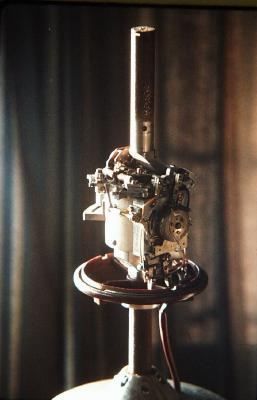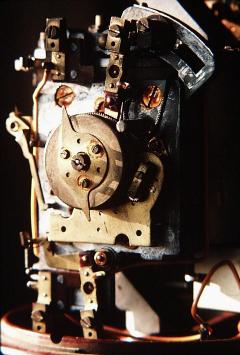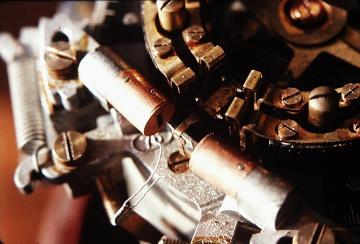The German WWII Magnetic Mine
|
The magnetic mine — as distinct from the more familiar floating contact mine
(the one with the spikes, familiar from the movies) — lies in wait on the
sea bottom. A ship passing tens of metres above (unless
'degaussed') distorts
the normal Earth's magnetic field enough to trigger the mine.
(A different type of device is also sometimes referred to as a "magnetic mine". The Limpet Mine is "magnetic" in the sense that it has a hefty magnet that lets an operator attach it personally to the hull of a ship, to be detonated when he is at a safe distance. These are not considered here.) | ||
![[Magnetic Mine photo]](MagMine_MkI.jpg)
The original Mark I Magnetic Mine ('Type GA')This is the actual device that landed on the mud flats in the Thames Estuary in November 1939, and provided the clues needed to develop countermeasures. [Also seen in the 1970's BBC programme "The Secret War".] It is now on display in HMS Belfast on the South Bank of the Thames. (Belfast herself was damaged by a magnetic mine that same November.)
You can see a photo of it as it lay on the mud flats in 1939, together
with a picture of Lt Cdr John Ouvry and his crew — who actually
did the hazardous job of defusing it — on
HMS Vernon's own History pages. | ||
The Mechanism of a later-model Magnetic MineThe magnetic 'needle' is buried in the centre of the mechanism. The vertical rods above and below are 'mu-metal'* field concentrators. The whole unit was also sheathed in mu-metal, and swung in gimbals so that it remained in the orientation shown.
(This unit is still quite functional after some sixty years.
However it now lights a lamp when triggered, rather than blowing
itself to fragments each time!)
|

|
|
|
A page with photos and description of a slightly more complex model,
allowing several ships to pass before it actually explodes can be found
here. (Thanks to the detective work of Konstantinos Makaronas!) Those photos also show the enclosing mu-metal cylinder which I omitted from my shots. |

|

|
The Arming Mechanism |
The Firing MechanismThe visible part of the trigger is seen here. (The actual magnetism-sensitive element is deep inside.) The two 'copper' cylinders are actually also little magnets: their function is to grab the T-shaped element seen in the centre of the picture as soon as it deviates (due to a changing external field) far enough from the neutral position. This increases sensitivity, and ensures that the contact points — visible a little above and to the right — make firm contact. |
 feedback page
feedback page